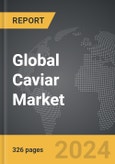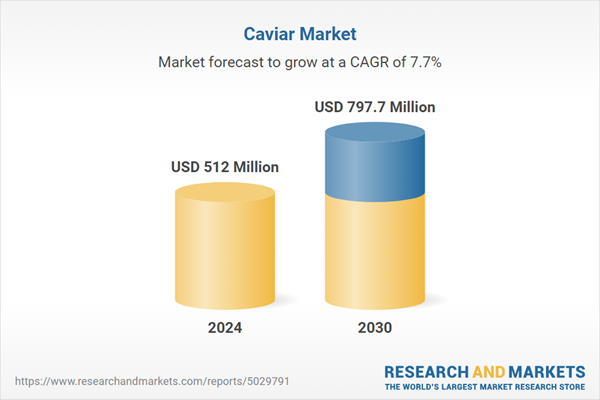The global market for Caviar was valued at US$512.0 Million in 2024 and is projected to reach US$797.7 Million by 2030, growing at a CAGR of 7.7% from 2024 to 2030. This comprehensive report provides an in-depth analysis of market trends, drivers, and forecasts, helping you make informed business decisions. The report includes the most recent global tariff developments and how they impact the Caviar market.
Segments: Product (Sevruga, Osetra, Salmon, Sushi, Other Products); Application (Restaurants, Household).
Geographic Regions/Countries: World; United States; Canada; Japan; China; Europe (France; Germany; Italy; United Kingdom; Spain; Russia; and Rest of Europe); Asia-Pacific (Australia; India; South Korea; and Rest of Asia-Pacific); Latin America (Argentina; Brazil; Mexico; and Rest of Latin America); Middle East (Iran; Israel; Saudi Arabia; United Arab Emirates; and Rest of Middle East); and Africa.
The analysts continuously track trade developments worldwide, drawing insights from leading global economists and over 200 industry and policy institutions, including think tanks, trade organizations, and national economic advisory bodies. This intelligence is integrated into forecasting models to provide timely, data-driven analysis of emerging risks and opportunities.
Global Caviar Market - Key Trends and Drivers Summarized
How Has Caviar Become a Symbol of Luxury and Fine Dining?
Caviar, the roe (eggs) of certain fish, particularly sturgeon, has long been regarded as a symbol of luxury and opulence in fine dining. The delicate texture, rich flavor, and rarity of caviar make it one of the most sought-after delicacies in the culinary world. Traditionally harvested from the Caspian Sea, caviar has a history steeped in prestige, often associated with royalty, high-end banquets, and gourmet cuisine. Its exclusivity stems not only from the meticulous process of extracting and preserving the roe but also from the scarcity of sturgeon, the fish species most prized for producing the finest caviar varieties, such as Beluga, Ossetra, and Sevruga. In recent years, caviar has gained even more prominence in global haute cuisine, with chefs and connoisseurs experimenting with different types, flavors, and presentations. Caviar is often enjoyed on its own, paired with traditional accompaniments like blinis, crème fraîche, or Champagne, though modern chefs continue to introduce innovative ways to incorporate it into contemporary dishes. As a luxurious food product, caviar continues to hold its place as a coveted indulgence, revered for both its taste and status.Why Is Caviar Still in High Demand Despite Its High Cost?
Caviar remains in high demand despite its cost, largely due to its association with exclusivity, tradition, and the complex, nuanced flavor profile that it offers. The process of producing high-quality caviar is labor-intensive and time-consuming, which contributes to its high price. Sturgeon, the fish from which true caviar is harvested, take years to mature before they produce eggs suitable for harvesting. This long maturation period, combined with the controlled, sustainable farming practices needed to preserve sturgeon populations, adds to the scarcity of the product. Additionally, many consumers view caviar not just as a food but as an experience - an indulgence that elevates special occasions and dining experiences. The rarity and heritage associated with traditional caviar also contribute to its desirability; certain types of caviar, such as Beluga, are prized for their scarcity and superior taste. Caviar's unique flavor, which combines salty, buttery and briny notes, appeals to food enthusiasts and gourmands seeking fine culinary experiences. Its versatility in pairing with various high-end beverages and dishes also ensures its continued presence on the menus of luxury restaurants and events. As global wealth grows and interest in gourmet food increases, caviar continues to hold its place as a status symbol, driving demand even amid its high price.How Are Sustainable Practices Transforming the Caviar Industry?
The caviar industry has undergone a significant transformation in recent years, largely driven by the need for sustainable practices to address overfishing and the depletion of wild sturgeon populations. Historically, overfishing in the Caspian Sea severely threatened sturgeon species leading to international regulations and efforts to curb illegal fishing and trade. In response, sustainable aquaculture has emerged as a key solution, with many caviar producers turning to farm-raised sturgeon to ensure a steady and ethical supply of roe. These aquaculture farms are meticulously regulated to provide a controlled environment where sturgeon can mature without harming wild populations, helping to preserve the species while maintaining the quality of the caviar. Additionally, advancements in farming technology have improved the quality and consistency of farmed caviar, allowing it to rival or even surpass wild-harvested caviar in terms of taste and texture. Many high-end caviar brands now emphasize their commitment to sustainability, appealing to eco-conscious consumers who are increasingly interested in ethically sourced luxury foods. As a result, sustainable farming has not only helped rejuvenate the industry but also expanded caviar’s availability to a broader market without compromising its premium status.What Are the Key Drivers of Growth in the Caviar Market?
The growth in the caviar market is driven by several key factors, including increasing global wealth, the expansion of luxury food markets, and a rising interest in gourmet cuisine. As disposable income grows in emerging economies, particularly in regions like Asia and the Middle East, more consumers are willing to invest in high-end products like caviar. The globalization of food culture, combined with greater accessibility to premium ingredients, has also contributed to the rising demand for caviar beyond its traditional markets in Europe and North America. Another significant driver is the growing number of fine dining restaurants and gourmet retailers incorporating caviar into their offerings. Caviar’s versatility in pairing with various foods, from seafood to desserts, and its association with luxury and celebration make it an attractive choice for upscale dining establishments. Additionally, the shift toward sustainable and ethically sourced products has expanded the market for farm-raised caviar, attracting consumers who prioritize both luxury and environmental responsibility. The increasing visibility of caviar in media, food festivals, and social events, where it is often showcased as a status symbol, further stimulates demand. Lastly, innovations in packaging and preservation techniques have improved the shelf life and accessibility of caviar, making it easier for consumers and restaurants to incorporate this delicacy into their menus, further driving market growth.Report Scope
The report analyzes the Caviar market, presented in terms of units. The analysis covers the key segments and geographic regions outlined below.Segments: Product (Sevruga, Osetra, Salmon, Sushi, Other Products); Application (Restaurants, Household).
Geographic Regions/Countries: World; United States; Canada; Japan; China; Europe (France; Germany; Italy; United Kingdom; Spain; Russia; and Rest of Europe); Asia-Pacific (Australia; India; South Korea; and Rest of Asia-Pacific); Latin America (Argentina; Brazil; Mexico; and Rest of Latin America); Middle East (Iran; Israel; Saudi Arabia; United Arab Emirates; and Rest of Middle East); and Africa.
Key Insights:
- Market Growth: Understand the significant growth trajectory of the Sevruga segment, which is expected to reach US$246.8 Million by 2030 with a CAGR of a 9.6%. The Osetra segment is also set to grow at 7.5% CAGR over the analysis period.
- Regional Analysis: Gain insights into the U.S. market, valued at $131.6 Million in 2024, and China, forecasted to grow at an impressive 11.6% CAGR to reach $202.3 Million by 2030. Discover growth trends in other key regions, including Japan, Canada, Germany, and the Asia-Pacific.
Why You Should Buy This Report:
- Detailed Market Analysis: Access a thorough analysis of the Global Caviar Market, covering all major geographic regions and market segments.
- Competitive Insights: Get an overview of the competitive landscape, including the market presence of major players across different geographies.
- Future Trends and Drivers: Understand the key trends and drivers shaping the future of the Global Caviar Market.
- Actionable Insights: Benefit from actionable insights that can help you identify new revenue opportunities and make strategic business decisions.
Key Questions Answered:
- How is the Global Caviar Market expected to evolve by 2030?
- What are the main drivers and restraints affecting the market?
- Which market segments will grow the most over the forecast period?
- How will market shares for different regions and segments change by 2030?
- Who are the leading players in the market, and what are their prospects?
Report Features:
- Comprehensive Market Data: Independent analysis of annual sales and market forecasts in US$ Million from 2024 to 2030.
- In-Depth Regional Analysis: Detailed insights into key markets, including the U.S., China, Japan, Canada, Europe, Asia-Pacific, Latin America, Middle East, and Africa.
- Company Profiles: Coverage of players such as Agroittica Lombarda SpA, AmStur Caviar, ATTILUS Caviar, Avori Caviar, California Caviar Company, LLC. and more.
- Complimentary Updates: Receive free report updates for one year to keep you informed of the latest market developments.
Some of the 48 companies featured in this Caviar market report include:
- Agroittica Lombarda SpA
- AmStur Caviar
- ATTILUS Caviar
- Avori Caviar
- California Caviar Company, LLC.
- Caviar de France
- Caviar De Riofrio S.L.
- Coastal Bay Seafoods
- Fortuna XXI
- Great Atlantic Trading Inc.
- Hangzhou Qiandaohu Xunlong Sci-tech Co. Ltd.
- Midwest Caviar LLC
- Northern Divine Caviar
- Russian Caviar House
- Sterling Caviar LLC
Tariff Impact Analysis: Key Insights for 2025
Global tariff negotiations across 180+ countries are reshaping supply chains, costs, and competitiveness. This report reflects the latest developments as of April 2025 and incorporates forward-looking insights into the market outlook.The analysts continuously track trade developments worldwide, drawing insights from leading global economists and over 200 industry and policy institutions, including think tanks, trade organizations, and national economic advisory bodies. This intelligence is integrated into forecasting models to provide timely, data-driven analysis of emerging risks and opportunities.
What’s Included in This Edition:
- Tariff-adjusted market forecasts by region and segment
- Analysis of cost and supply chain implications by sourcing and trade exposure
- Strategic insights into geographic shifts
Buyers receive a free July 2025 update with:
- Finalized tariff impacts and new trade agreement effects
- Updated projections reflecting global sourcing and cost shifts
- Expanded country-specific coverage across the industry
Table of Contents
I. METHODOLOGYII. EXECUTIVE SUMMARY2. FOCUS ON SELECT PLAYERSIII. MARKET ANALYSISSOUTH KOREAREST OF ASIA-PACIFICARGENTINABRAZILMEXICOREST OF LATIN AMERICAIRANISRAELSAUDI ARABIAUNITED ARAB EMIRATESREST OF MIDDLE EASTIV. COMPETITION
1. MARKET OVERVIEW
3. MARKET TRENDS & DRIVERS
4. GLOBAL MARKET PERSPECTIVE
UNITED STATES
CANADA
JAPAN
CHINA
EUROPE
FRANCE
GERMANY
ITALY
UNITED KINGDOM
SPAIN
RUSSIA
REST OF EUROPE
ASIA-PACIFIC
AUSTRALIA
INDIA
LATIN AMERICA
MIDDLE EAST
AFRICA
Companies Mentioned (Partial List)
A selection of companies mentioned in this report includes, but is not limited to:
- Agroittica Lombarda SpA
- AmStur Caviar
- ATTILUS Caviar
- Avori Caviar
- California Caviar Company, LLC.
- Caviar de France
- Caviar De Riofrio S.L.
- Coastal Bay Seafoods
- Fortuna XXI
- Great Atlantic Trading Inc.
- Hangzhou Qiandaohu Xunlong Sci-tech Co. Ltd.
- Midwest Caviar LLC
- Northern Divine Caviar
- Russian Caviar House
- Sterling Caviar LLC
Table Information
| Report Attribute | Details |
|---|---|
| No. of Pages | 326 |
| Published | April 2025 |
| Forecast Period | 2024 - 2030 |
| Estimated Market Value ( USD | $ 512 Million |
| Forecasted Market Value ( USD | $ 797.7 Million |
| Compound Annual Growth Rate | 7.7% |
| Regions Covered | Global |









